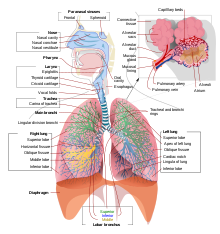User:Bobtheabob/sandbox
Caffeine[edit]

Article is about caffeine as a stimulant drug.
Caffeine is a natural psychoactive compound belonging to the xanthine class of alkaloids, commonly found in various plant sources, known for its stimulant properties, and widely consumed by humans through beverages like coffee, tea, and energy drinks as well as in certain medications and dietary supplements.[1]
Metabolism, Physiological Effects, and Toxic Effects[edit]
Caffeine, a natural stimulant found in various beverages like coffee and tea, can exert several effects on metabolism. It is known to increase energy expenditure by stimulating thermogenesis, which leads to a slight elevation in the metabolic rate. Moreover, caffeine enhances lipolysis, the process of breaking down fat stored in adipose tissue, potentially providing an additional source of energy. It promotes glycogenolysis, the breakdown of glycogen into glucose, which can offer a quick energy boost. In some individuals, caffeine may also act as an appetite suppressant, leading to temporary reductions in food intake and influencing overall energy balance. It is important to note that individual responses to caffeine can vary, and the long-term effects on body weight and composition remain a subject of ongoing research. As with any substance, moderation in consumption is advised to avoid potential adverse effects and to promote overall well-being.[2]
Among the notable physiological effects of caffeine are its stimulant properties, which include increased alertness, improved concentration, and enhanced cognitive function. Caffeine acts as an adenosine receptor antagonist, meaning it competes with adenosine, a neurotransmitter that promotes relaxation and drowsiness, for binding to its receptors. By doing so, caffeine effectively blocks adenosine's calming effects, leading to increased wakefulness and reduced feelings of fatigue. Caffeine can lead to the release of neurotransmitters such as dopamine and norepinephrine, which play vital roles in mood regulation and the "fight-or-flight" response. This neurochemical modulation contributes to the temporary alleviation of fatigue and enhanced mood upon caffeine consumption.
Physiologically, caffeine also affects cardiovascular functions. It can cause a transient increase in heart rate and blood pressure, due to its action on the sympathetic nervous system. These effects are generally mild in healthy individuals but may be more pronounced in sensitive or susceptible populations.
At excessive levels of intake, caffeine can lead to various side effects, including heightened anxiety, restlessness, nervousness, dysphoria, insomnia, excitement, psychomotor agitation, and incoherent speech. Toxic effects are likely to manifest at consumption levels exceeding 1.2 grams, and a dose of 10 to 14 grams is considered potentially fatal. A recent review analyzing blood caffeine levels in fatal overdose cases found that the median postmortem blood caffeine concentration was 180 mg per liter, corresponding to an estimated caffeine intake of 8.8 grams.[3]
Enhancing performance[edit]
Caffeine can enhance exercise performance by reducing the perception of effort, boosting alertness, and improving mood and motivation. Its physiological effects, such as increasing adrenaline release and influencing energy metabolism, contribute to enhanced performance in both aerobic and anaerobic activities.
Given its performance-enhancing potential, caffeine is a widely used ergogenic aid in the sports and fitness community. Athletes and individuals seeking to optimize their exercise performance should consider their tolerance levels and adhere to recommended dosage guidelines for responsible and safe caffeine consumption.[4]
Medical[edit]

Caffeine finds various medical applications owing to its pharmacological properties. One prominent use is in premature infants with apnea of prematurity, where it stimulates the respiratory system and reduces the frequency of breathing pauses. Additionally, caffeine is an ingredient in certain over-the-counter pain relievers, enhancing their efficacy in treating headaches and migraines. It is sometimes combined with pain medications to improve analgesia. Caffeine's bronchodilator properties make it valuable in managing asthma exacerbations. It can be employed to raise blood pressure in cases of orthostatic hypotension and has shown potential neuroprotective effects in premature infants. Caffeine aids in combating fatigue and promoting mental alertness, often included in medications for this purpose. In diagnostic contexts, caffeine serves as a helpful aid for specific medical tests. Its medical use must be carefully administered under professional guidance, considering individual responses and potential interactions with other medications.[5]
References[edit]
Citations
Grgic, Jozo, et al. "Wake Up and Smell the Coffee: Caffeine Supplementation and Exercise performance—an Umbrella Review of 21 Published Meta-Analyses." British Journal of Sports Medicine, vol. 54, no. 11, 2020, pp. 681-688. ProQuest, https://eznvcc.vccs.edu/login?url=https://www.proquest.com/scholarly-journals/wake-up-smell-coffee-caffeine-supplementation/docview/2512743726/se-2, doi:https://doi.org/10.1136/bjsports-2018-100278.
Davis, J.K., and J. Matt Green. "Caffeine and anaerobic performance: ergogenic value and mechanisms of action." Sports Medicine, vol. 39, no. 10, Oct. 2009, pp. 813+. Gale OneFile: Health and Medicine, link.gale.com/apps/doc/A217512205/HRCA?u=viva2_nvcc&sid=bookmark-HRCA&xid=eedafb1b. Accessed 30 July 2023.
Franke, Andreas G., et al. "What Users Think about the Differences between Caffeine and Illicit/Prescription Stimulants for Cognitive Enhancement." PLoS ONE, vol. 7, no. 6, 29 June 2012, p. e40047. Gale Health and Wellness, link.gale.com/apps/doc/A477004465/HWRC?u=viva2_nvcc&sid=bookmark-HWRC&xid=725af058. Accessed 30 July 2023..
Rogers, Peter J., et al. "Faster but not smarter: effects of caffeine and caffeine withdrawal on alertness and performance." Psychopharmacology, vol. 226, no. 2, 15 Mar. 2013, pp. 229+. Gale OneFile: Health and Medicine, link.gale.com/apps/doc/A337287635/HRCA?u=viva2_nvcc&sid=bookmark-HRCA&xid=dbf7cebc. Accessed 30 July 2023.
van Dam, Rob M., et al. “Coffee, Caffeine, and Health.” The New England Journal of Medicine, vol. 383, no. 4, 2020, pp. 369–78, https://doi.org/10.1056/NEJMra1816604.
- ^ "Shibboleth Authentication Request". login.eznvcc.vccs.edu. doi:10.1056/nejmra1816604. Retrieved 2023-07-30.
- ^ "Shibboleth Authentication Request". login.eznvcc.vccs.edu. Retrieved 2023-07-30.
- ^ Davis, J.K.; Green, J. Matt (2009-10). "Caffeine and Anaerobic Performance". Sports Medicine. 39 (10): 813–832. doi:10.2165/11317770-000000000-00000. ISSN 0112-1642.
{{cite journal}}: Check date values in:|date=(help) - ^ "Wake up and smell the coffee: caffeine - ProQuest". www.proquest.com. Retrieved 2023-07-30.
- ^ "Shibboleth Authentication Request". login.eznvcc.vccs.edu. Retrieved 2023-07-30.

